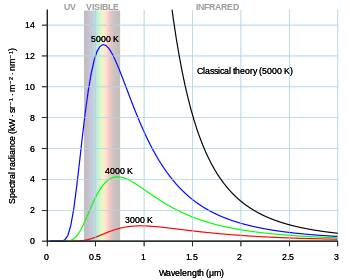Ultraviolet catastrophe

The ultraviolet catastrophe, also called the Rayleigh–Jeans catastrophe, was a prediction of late 19th century/early 20th century classical physics that an ideal black body at thermal equilibrium will emit radiation with infinite power.
The term "ultraviolet catastrophe" was first used in 1911 by Paul Ehrenfest, although the concept goes back to 1900 with the first derivation of the  dependence of the Rayleigh–Jeans law; the word "ultraviolet" refers to the fact that the problem appears in the short wavelength region of the electromagnetic spectrum. Since the first appearance of the term, it has also been used for other predictions of a similar nature, as in quantum electrodynamics and such cases as ultraviolet divergence.
dependence of the Rayleigh–Jeans law; the word "ultraviolet" refers to the fact that the problem appears in the short wavelength region of the electromagnetic spectrum. Since the first appearance of the term, it has also been used for other predictions of a similar nature, as in quantum electrodynamics and such cases as ultraviolet divergence.
Problem
The ultraviolet catastrophe results from the equipartition theorem of classical statistical mechanics which states that all harmonic oscillator modes (degrees of freedom) of a system at equilibrium have an average energy of  .
.
An example, from Mason's A History of the Sciences,[1] illustrates multi-mode vibration via a piece of string. As a natural vibrator, the string will oscillate with specific modes (the standing waves of a string in harmonic resonance), dependent on the length of the string. In classical physics, a radiator of energy will act as a natural vibrator. And, since each mode will have the same energy, most of the energy in a natural vibrator will be in the smaller wavelengths and higher frequencies, where most of the modes are.
According to classical electromagnetism, the number of electromagnetic modes in a 3-dimensional cavity, per unit frequency, is proportional to the square of the frequency. This therefore implies that the radiated power per unit frequency should follow the Rayleigh–Jeans law, and be proportional to frequency squared. Thus, both the power at a given frequency and the total radiated power is unlimited as higher and higher frequencies are considered: this is clearly unphysical as the total radiated power of a cavity is not observed to be infinite, a point that was made independently by Einstein and by Lord Rayleigh and Sir James Jeans in the year 1905.
Solution
Planck derived the correct form for the intensity spectral distribution function by making some strange (for the time) assumptions. In particular, Planck assumed that electromagnetic radiation can only be emitted or absorbed in discrete packets, called quanta, of energy:  , where h is Planck's constant.
Planck's assumptions led to the correct form of the spectral distribution functions:
, where h is Planck's constant.
Planck's assumptions led to the correct form of the spectral distribution functions:  .
Albert Einstein solved the problem by postulating that Planck's quanta were real physical particles—what we now call photons, not just a mathematical fiction. He modified statistical mechanics in the style of Boltzmann to an ensemble of photons. Einstein's photon had an energy proportional to its frequency and also explained an unpublished law of Stokes and the photoelectric effect.[2]
.
Albert Einstein solved the problem by postulating that Planck's quanta were real physical particles—what we now call photons, not just a mathematical fiction. He modified statistical mechanics in the style of Boltzmann to an ensemble of photons. Einstein's photon had an energy proportional to its frequency and also explained an unpublished law of Stokes and the photoelectric effect.[2]
Historical inaccuracies
Many popular histories of physics, as well as a number of physics textbooks, present an incorrect version of the history of the ultraviolet catastrophe. In this version, the "catastrophe" was first noticed by Planck, who developed his formula in response. In fact Planck never concerned himself with this aspect of the problem, because he did not believe that the equipartition theorem was fundamental – his motivation for introducing "quanta" was entirely different. That Planck's proposal happened to provide a solution for it was realized only later, as stated above.[3] Though the true sequence of events has been known to historians for many decades, the historically incorrect version persists, in part because Planck's actual motivations for the proposal of the quantum are complicated and difficult to summarize for a lay audience.[4]
In popular culture
Ultraviolet catastrophe has appeared in popular culture as the title to a children's book by New Zealand author Margaret Mahy. The reference in the title isn't directly related to the physics concept, but rather to the catch-phrase of the main character's great-uncle who would have been roughly contemporary with the discovery of Planck's constant.
In 1998, The Chemical Brothers released a DJ mix CD called Brothers Gonna Work It Out, which featured a song by a San Francisco techno / breakbeat band named The Ultraviolet Catastrophe.
See also
References
- ↑ Mason, MA, PhD, Stephen (1962). A History of the Sciences. New York, NY: Collier Books. p. 550.
- ↑ Einstein and the Quantum, A. Douglas Stone, Princeton University Press, 2013
- ↑ Kragh, Helge (December 2000). "Max Planck: The reluctant revolutionary". Physics World.
- ↑ For some of the historiographical debates over what actually motivated Planck, see
Kuhn, Thomas (1978). Black-Body Theory and the Quantum Discontinuity: 1894–1912. Clarendon Press, Oxford. ISBN 0-226-45800-8.
Galison, Peter (1981). "Kuhn and the Quantum Controversy". British Journal for the Philosophy of Science 32 (1): 71–85. doi:10.1093/bjps/32.1.71.
- Kroemer, Herbert; Kittel, Charles (1980). Thermal Physics (2nd ed.). W. H. Freeman Company. Chapter 4. ISBN 0-7167-1088-9.
- Cohen-Tannoudji, Claude; Diu, Bernard; Laloë, Franck (1977). Quantum Mechanics: Volume One. Hermann, Paris. pp. 624–626. ISBN 0-471-16433-X.